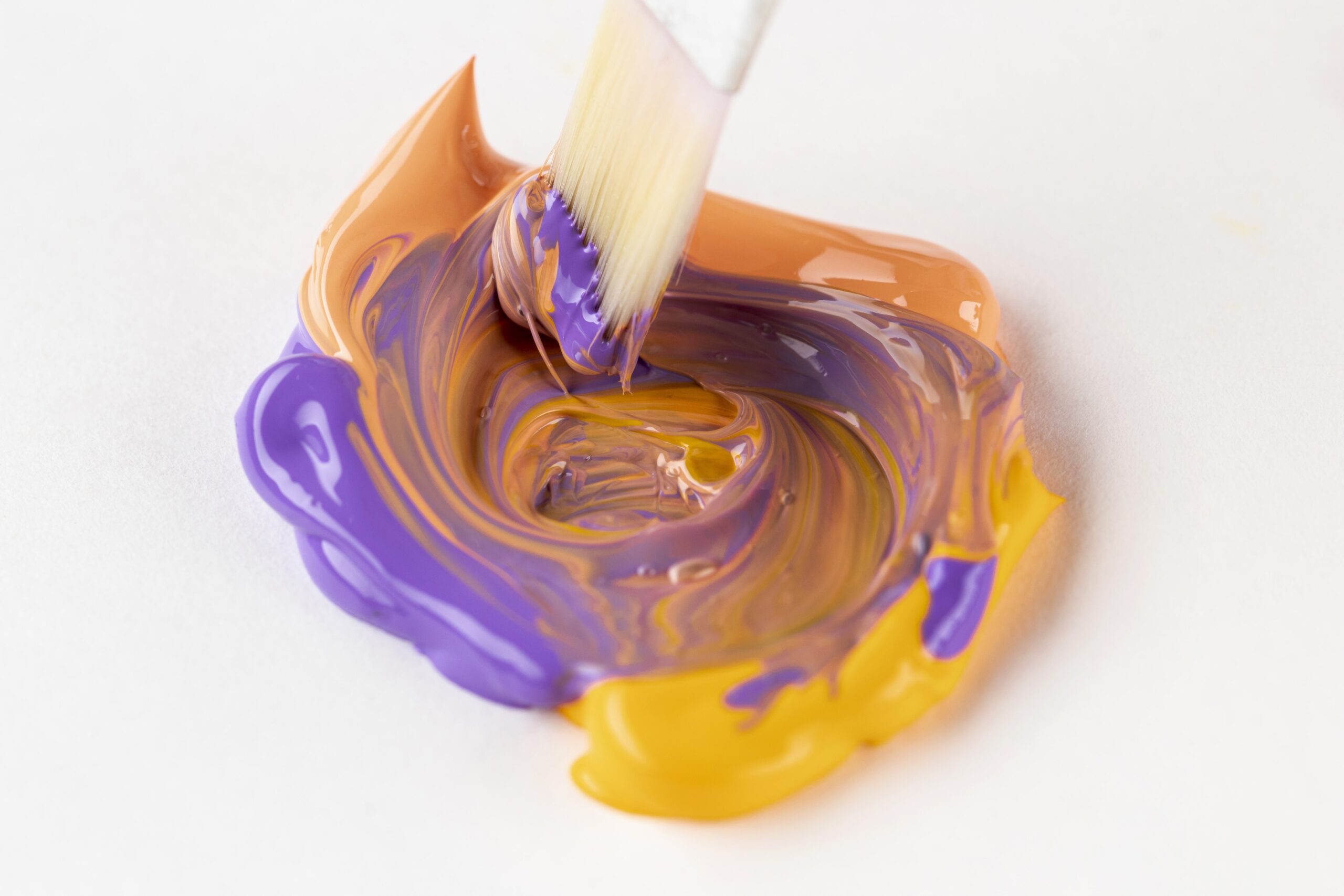
In the realm of artistic expression, blending of acrylic colors stands as a captivating technique that brings life and dimension to your creations. The seamless merging of hues on canvas is a skill that transforms static pigments into dynamic, flowing compositions. This comprehensive guide takes you on a journey through the art and technique of blending of acrylic colors, exploring the methods, nuances, and the boundless creative potential that arises when colors harmonize on your canvas.
Chapter 1: The Dynamics of Acrylic Color Blending
Before delving into the techniques of blending of acrylic colors, it’s essential to understand the dynamics at play. Acrylic paint, known for its versatility and fast-drying nature, provides artists with a rich medium for exploration. Let’s delve into the foundational aspects:
1-Understanding Acrylic Paint Characteristics
Acrylic paint consists of pigments suspended in a water-based emulsion. Its characteristics, including opacity, viscosity, and drying time, influence how colors blend. Different formulations of acrylic paint, such as heavy body and fluid acrylics, offer varying consistencies suitable for different blending techniques.
2-The Role of Color Bias
Each color has its unique characteristics, and understanding color bias is crucial when blending. Color bias refers to the subtle undertones present in a color. For instance, a blue may have a cool or warm bias, influencing how it interacts with other colors during blending.
Chapter 2: Techniques for Seamless Acrylic Color Blending
Technique 1: Wet-on-Wet Blending
Wet-on-wet blending involves applying wet paint directly onto an already wet surface. This technique allows colors to meld effortlessly, creating smooth transitions and gradients. To execute this method, work quickly and keep your paints adequately moist to maintain a fluid blending experience.
Technique 2: Dry Brush Blending
Dry brush blending is ideal for artists seeking more control over the blending process. In this technique, a minimal amount of paint is applied to a dry brush, allowing for subtle layering and controlled color transitions. This method is particularly effective for creating texture and detailing within a painting.
Technique 3: Feathering
Feathering involves delicately dragging one color into another, creating a feathery or soft edge. This technique is excellent for achieving subtle transitions between colors, especially in areas where a seamless, gradual shift is desired. Feathering requires a light touch and controlled brush movements.
Technique 4: Glazing
Glazing is a layering technique where transparent or translucent layers of paint are applied over dry underlying colors. This method is fantastic for building depth and complexity. By gradually layering glazes, artists can achieve a luminous quality in their paintings.
Chapter 3: Creating Dimension with Acrylic Color Blending
Dimensional Effect 1: Atmospheric Perspective
Blending of acrylic colors is a powerful tool for creating atmospheric perspective in your artwork. By blending colors to become lighter and less saturated in the background, you can simulate the effect of distance and depth, enhancing the three-dimensional quality of your composition.
Dimensional Effect 2: Highlight and Shadow
Effective blending is key to achieving realistic highlights and shadows. By skillfully transitioning between lighter and darker shades, artists can create the illusion of volume and form. Paying attention to the direction of light and shadow enhances the realism of your artwork.
Dimensional Effect 3: Textured Surfaces
Blending of acrylic colors can be employed to create textured surfaces. By layering and blending paint with a palette knife or brush, artists can produce intricate textures that add tactile interest to their artwork. This technique is particularly effective for subjects like landscapes and abstract pieces.
Dimensional Effect 4: Seamless Color Transitions
The hallmark of expert blending is the creation of seamless color transitions. Whether transitioning from one hue to another or blending variations of a single color, achieving smooth and cohesive transitions adds a professional touch to your artwork. Practicing gradual shifts and experimenting with different blending techniques contribute to mastering this skill.
Chapter 4: Overcoming Challenges in Acrylic Color Blending
While blending of acrylic colors can be a gratifying experience, artists may encounter challenges along the way. Addressing these challenges head-on ensures a smoother blending process and enhances the overall quality of your artwork.
Challenge 1: Overblending
Overblending can lead to the loss of color vibrancy and a muddy appearance. To overcome this challenge, practice restraint and allow some unmixed areas to add visual interest and dynamism to your piece.
Challenge 2: Inconsistent Drying Times
Acrylic paint dries quickly, and inconsistent drying times can affect the blending process. To overcome this challenge, work efficiently, and consider using retarders or a wet palette to extend the drying time of your paints.
Challenge 3: Transitioning Between Opacities
Blending colors with different opacities can be tricky. To overcome this challenge, experiment with layering techniques and consider adjusting the transparency of your paints with mediums or water to achieve more uniform blends.
Challenge 4: Achieving Color Consistency
Maintaining color consistency across a large canvas or series is a common challenge. To address this, mix larger quantities of a color and keep a record of your ratios. This ensures uniformity and coherence in your color scheme.
Chapter 5: Pushing Boundaries with Experimental Blending
Experiment 1: Color Combinations
Push the boundaries of traditional color schemes by experimenting with unconventional color combinations. Discover the emotional impact of unexpected hues and explore how blending disparate colors can create unique visual expressions.
Experiment 2: Texture and Mixed Media
Combine acrylic color blending with various textures and mixed media elements. Incorporate materials like sand, fabric, or even collage elements into your artwork. This experimental approach adds depth and richness to your blended compositions.
Experiment 3: Abstract Blending
Embrace abstraction by allowing the colors to flow and blend organically on the canvas. Use a variety of tools, such as sponges, rags, or even your fingers, to create spontaneous and dynamic blends. Abstract blending invites a sense of freedom and unpredictability into your artistic process.
Experiment 4: Reverse Blending
Challenge traditional blending norms by experimenting with reverse blending. Instead of transitioning from light to dark, start with a dark base and blend toward lighter tones. This unconventional approach can yield surprising and visually engaging results.
Conclusion:
Blending of acrylic colors is more than a technical skill; it’s an art form that allows you to orchestrate a symphony of hues on your canvas. From mastering fundamental techniques to overcoming challenges and pushing the boundaries with experimentation, the journey of blending colors is a continuous exploration.
As you embark on this creative voyage, embrace the ebb and flow of colors, celebrate the unexpected, and let your brush dance across the canvas. The art of blending of acrylic colors is a celebration of harmony, expression, and the limitless possibilities that arise when colors seamlessly come together.



